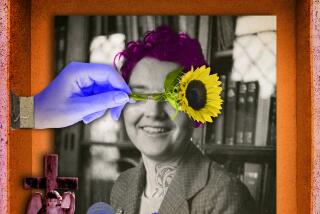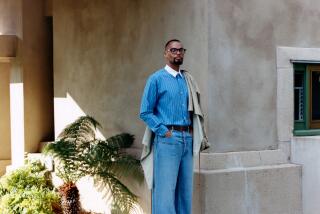MacArthur fellow Lauren Redniss sees the art in science
- Share via
Lauren Redniss was awarded the MacArthur Fellowship for her nonfiction graphic storytelling, work that is both grounded and distinctly artful. “Radioactive,” about the relationship between Pierre and Marie Curie and their scientific discoveries, was a finalist for the National Book Award; it was followed by 2015’s “Thunder and Lightning,” a book that was about the weather and more. Redniss, a professor at Parsons, New School for Design in New York, matches her materials to her subjects in surprising ways. We talked to her by phone.
It seems like you have not shied away from taking risks in your work, but what will this grant mean for you? Can you take bigger risks?
I think so, yes. I think that it blows open the possibilities. I don’t know precisely what that will mean just yet, but already with my current project it gives a new kind of confidence. In my work, I take a lot of oral histories, and I want my work to be as true to those people’s stories, and to be worthy of the trust that they give to me, so any way that I can do a better, stronger version of what I’ve been doing. But who knows! There’s so many ideas through the years that pop into my head, and, you know, I think, that’s totally impossible, I can’t do that. But now: Why not?
Where am I catching you?
I just dropped my son off at school, and I’m doing errands before I get down to work in Brooklyn.
While working on “Radioactive,” you’ve said that your darkroom was a bathroom or closet?
Yes. I made the prints for that book with a technique called cyanotype printing, which is like a camera-less photographic technique. I wanted to echo the themes in the book; that medium uses the ultraviolet rays of the sun. It uses invisible penetrating rays to create the images, in a book about the invisible penetrating rays that the Curies, my subjects, had discovered. I had to make a darkroom, but I didn’t have a photographic studio. At one point I was working in Paris so I converted the bathroom, I taped up everything with garbage bags and painters tape and had, probably, lots of toxic chemicals around. Then I used my kitchen when I was back in New York — even, I’m sure, a worse idea. Don’t drink that!
In some ways, New York provides physical limitations to someone who’s trying to work with different media. Do you have a studio, or could you have one with this fellowship?
It’s true. Over the years, I’ve sort of reduced the means with which I create images to a piece of paper and a pencil, so I could draw when I was out on location. Which works for me because I’m always reporting stories, either talking to people or drawing. So having a really compact set of tools is really good. But, yeah, I have a Murphy bed, so in the morning I flip up my bed and my bedroom becomes my quote-unquote studio. It’s pretty tight. I don’t know — it hadn’t even crossed my mind.
Are there any prior fellows whose work you’ve admired?
Yeah, I work with Ben Katchor, and Jean Strouse, who is also an incredible scholar. And other artists I admire: Basil Twist, and I’m one of the legions of Lin-Manuel Miranda fans. Sarah Sze. There are so many. So many artists in so many different fields, and of course scientists too. And educators.

Your last two books have involved science. Without revealing too much, does the next one?
Yes. There’s a geological layer to it. No pun intended.
What was it like explaining your work to people in publishing at first?
I definitely had a hard time getting traction in the beginning. People said, That’s too weird. My first book, I finally managed to get a literary agent, and even her assistant wouldn’t call me back. It was not going well. But there have been people who have been supportive, and I have been so fortunate. Even when it did seem extremely unlikely that this kind of work would find an audience, there were people who supported me, and I am so grateful for that.
Do you see books as your central project?
Yeah, at least for now. They have been, and I love making books. But I don’t know. There are other things I have always wanted to do and make, and I think that is one of the things that the fellowship opens up again. It does feel like I could take a complete left turn, and that would be more OK than it would have been otherwise.
What was it like to learn of the fellowship?
I was so stunned. I think it just continues to sink in. Because it’s been a secret up until now, that maintains the sense of unreality. Now it’s like, maybe this is happening. It’s a really nice feeling.
2016 MacArthur fellows:
More to Read
Sign up for our Book Club newsletter
Get the latest news, events and more from the Los Angeles Times Book Club, and help us get L.A. reading and talking.
You may occasionally receive promotional content from the Los Angeles Times.









